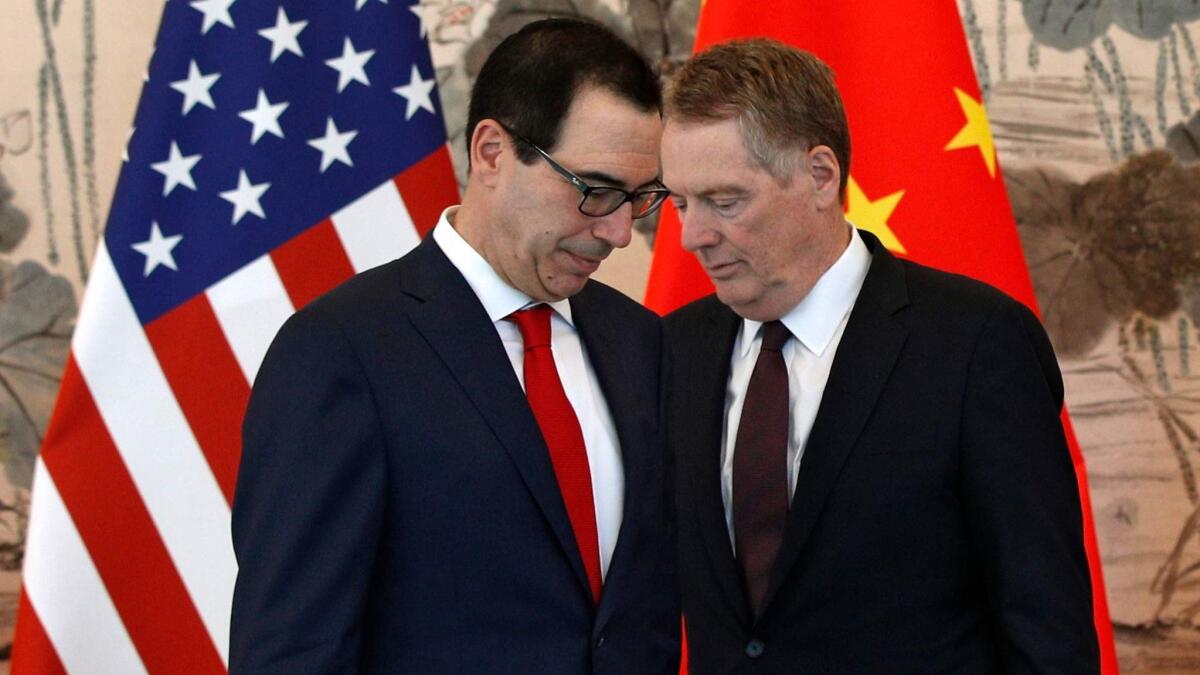Opinion: The World Trade Organization just bared its toothless gums in ruling for China

- Share via
A World Trade Organization panel ruled Tuesday the Trump administration violated international trade rules by trying to stop China’s blatant violations of international trade rules.
The ruling probably won’t make a whit of difference in the ongoing trade fight between the two countries, however, because the administration has undermined the WTO’s enforcement powers to such a degree the body won’t be able to impose any sanctions.
The outcome of the two-plus years spent in the dispute resolution process will only affirm the administration’s hostility toward the WTO. But it highlights the need to overhaul the body’s rules to make them relevant again, an effort that the United States could and should be leading.
There is more than a little irony when you dive into the details of the dispute. China, which was admitted to the WTO late in 2001, regularly draws accusations of being a trade cheat. Among other things, critics say China’s state-owned enterprises benefit from both subsidies and barriers to competition by foreign firms, and that foreign companies are forced to give up intellectual property by the Chinese partners they are required to take on. Oh and yes, state-backed hackers steal copious amounts of trade secrets.
The United States, meanwhile, has been one of the world’s foremost champions of a globalized system of rules that was supposed to end tit-for-tat tariff battles like the ones President Trump has waged with just about all of our trading partners.
Previous U.S. administrations have tried to pressure China to change its ways. When those efforts were unavailing, President Obama sought to assemble a trading bloc among Pacific nations that would raise competitive standards. President Trump abandoned the Trans-Pacific Partnership in favor of unilateral, blunt-force action in 2018, levying tariffs of 10% to 25% on a broad swath of Chinese goods and prompting China’s complaint to the WTO.
In particular, the WTO panel noted, the administration was seeking to end China’s “state-sanctioned theft and misappropriation of U.S. technology, intellectual property, and commercial secrets.” The point was to inflict enough pain on the Chinese economy that Beijing would finally amend its ways and compete fairly.
The tariffs helped bring China to the negotiating table, yielding a modest deal that called for increased Chinese purchases of U.S. exports (a commitment that China is not living up to, at least not yet) and better protection of U.S. intellectual property. That’s a promise China has made before; this time, however, it comes with enforcement mechanisms that could actually make a difference.
Even as it was negotiating a deal, however, China was also pursuing the WTO’s help in lifting the U.S. tariffs, which led to Tuesday’s ruling. While the U.S. had the right to impose tariffs to protect against intellectual property theft, the panel found, it couldn’t simply try to coerce China into submission. The tariffs had to fall on products and services related to the industries affected by China’s improper behavior. And the Trump administration failed to show “that there is a genuine relationship of ‘ends and means,’” the panel concluded.
You could practically hear U.S. Trade Representative Robert Lighthizer smack himself in the forehead. “Although the panel did not dispute the extensive evidence submitted by the United States of intellectual property theft by China,” Lighthizer said, “its decision shows that the WTO provides no remedy for such misconduct. The United States must be allowed to defend itself against unfair trade practices, and the Trump administration will not let China use the WTO to take advantage of American workers, businesses, farmers, and ranchers.”
Jeffrey Schott, a senior fellow at the Peterson Institute for International Economics and a former trade negotiator for the U.S., is no fan of Trump’s tariffs. But he agreed with Lighthizer on that point, saying, “the WTO rules are inadequate to address the Chinese practices that distort trade and investment.”
The U.S. would have been within its rights to retaliate against China by using measures not governed by international trade rules — for example, by negotiating a multilateral free-trade deal that gives China’s trading partners more incentive to buy from other countries. “But because President Trump is so enamored with tariffs — and he believes his supporters will understand [them] … the U.S. response has focused primarily on tariff retaliations,” Schott said.
By the way, the U.S. also could have filed a complaint with the WTO challenging the tariffs China imposed on U.S. goods in retaliation, making the same argument about “ends and means” that China made. It did not.
Still, the U.S. was really in a no-lose position here. By blocking appointments to the WTO panel that hears appeals, the United States has ensured that it — or any other country facing sanctions by the WTO — merely has to appeal an adverse decision, where it will be stuck in limbo, Schott said.
As a result, countries are left to pound each other with tariffs and other protectionist policies just like the old days that the U.S., prior to Trump, had worked diligently to end.
The globalization of the economy and the rise of India and China as manufacturing powerhouses within the developing world has changed the playing field dramatically. But updating the WTO rules will require China and India to buy into them, and the path there is unclear.
More to Read
A cure for the common opinion
Get thought-provoking perspectives with our weekly newsletter.
You may occasionally receive promotional content from the Los Angeles Times.











